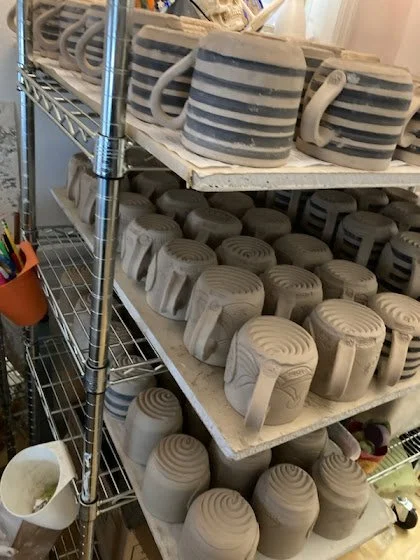
Ceramics Supplies & Equipment
Ceramics requires a variety of tools to shape, texture, and finish clay creations. Here's a list of common ceramics tools:
Pottery Wheel: Used for throwing clay to create symmetrical vessels like bowls, cups, and vases.
Clay: The primary material for ceramics, available in different types such as earthenware, stoneware, and porcelain.
Clay Tools:
Wire Cutter: Used to cut clay from the block or remove pieces from the wheel.
Needle Tool: For trimming excess clay, scoring surfaces for joining, or creating fine details.
Rib Tools: Used for shaping and smoothing clay surfaces.
Loop Tool: Helps in carving and sculpting clay.
Rolling Pin: Used for rolling out slabs of clay for handbuilding techniques.
Slab Roller: A machine used to roll out consistent slabs of clay for larger handbuilt projects.
Clay Extruder: A tool that pushes clay through a shaped die to create coils or other uniform shapes.
Kiln: A furnace for firing clay creations at high temperatures to harden them into ceramic objects.
Kiln Furniture: Refractory materials such as kiln shelves, posts, and stilts used to support ceramic pieces during firing.
Glazes: Colored, glass-like coatings applied to ceramics to decorate and seal them.
Brushes and Sponges: Used to apply glazes, underglazes, and slips onto ceramic surfaces.
Fettling Knife: A sharp tool used for trimming and refining the edges of clay pieces.
Calipers: Used to measure the thickness or diameter of clay objects for uniformity.
Banding Wheel: A rotating platform for handbuilding or decorating ceramics, allowing for easy access to all sides of the piece.
Sculpting Tools: Various tools such as sculpting knives, wire tools, and modeling tools for shaping and detailing clay sculptures.
Spray Bottle: Used to mist clay surfaces to keep them moist during handbuilding or carving.
Sgraffito Tools: Sharp tools for scratching designs into clay surfaces.
Sponges and Rags: Used for smoothing, shaping, and cleaning clay surfaces.
Glaze Tongs and Gloves: Tools for safely handling glazed pieces before and after firing.
These are just some of the essential tools used in ceramics, but there are many more specialized tools available for different techniques and purposes.
But… Do we need all of these supplies?
Absolutely not!!!
We have all of the materials and supplies that you will need for classes! However, if you are interested in having a set of supplies to work with at home, we recommend the folks at Fat Cat Pottery:
2500 Blue Clay Rd, Wilmington, NC 28405 / (910) 395-2529
Studio Rules
Establishing clear studio rules is essential for maintaining a safe, productive, and enjoyable environment for everyone using the clay studio. By adhering to these rules, everyone can contribute to a harmonious and productive clay studio environment. It's important to review and reinforce these rules regularly to ensure compliance and maintain a positive studio culture. Here's a list of common clay studio rules:
Safety First:
Always wear appropriate protective gear, such as goggles, aprons, and gloves when handling clay or using equipment.
Use tools and equipment safely and responsibly, following proper operating procedures.
Report any safety hazards or accidents immediately to the studio manager or instructor.
Respect for Others:
Respect the space and belongings of other studio users, including their projects, tools, and materials.
Avoid disturbing or distracting others while they work.
Be mindful of noise levels and maintain a peaceful atmosphere in the studio.
Cleanliness and Organization:
Keep the studio clean and tidy by cleaning up after yourself and returning tools and materials to their proper places.
Wipe down work surfaces and equipment after use to prevent clay buildup and maintain a hygienic environment.
Dispose of clay scraps, trimmings, and other waste materials in designated bins.
Clay Handling and Preparation:
Use clay responsibly and avoid wastefulness by only taking what you need for your projects.
Properly wedge and knead clay to remove air bubbles and ensure uniform consistency.
Keep clay moist by covering it with plastic or damp towels when not in use to prevent drying out.
Equipment Use:
Use pottery wheels, kilns, extruders, and other equipment with care and following proper procedures.
Clean equipment after each use and report any malfunction or damage to the studio manager.
Respect equipment usage limits and be mindful of others waiting to use shared equipment.
Firing Procedures:
Follow the studio's firing schedule and guidelines for loading and unloading kilns.
Label your ceramic pieces clearly with your name and any specific firing instructions.
Avoid placing non-fireable materials or improperly prepared pieces in the kiln.
Personal Conduct:
Behave respectfully and courteously towards fellow studio users, instructors, and staff.
Refrain from engaging in disruptive or inappropriate behavior, including harassment or discrimination.
Maintain a positive attitude and be open to constructive feedback and collaboration.
Studio Hours and Access:
Adhere to the studio's operating hours and policies regarding access to the facility.
Respect designated studio spaces and avoid entering restricted areas without permission.
Sign in and out of the studio if required for attendance tracking or security purposes.
Guests and Visitors:
Obtain permission from studio management before bringing guests or visitors into the studio.
Ensure that guests follow the same rules and guidelines as studio members.
Communication:
Communicate openly and respectfully with studio staff and fellow members regarding any concerns or issues.
Seek assistance or clarification if you are unsure about studio policies or procedures.
Questions or Comments —





